Tips and Tricks
Simplex/Duplex
After attempting to help a couple of Foundation licence holders with the programming of their FT-991(A)s, I had to point out to them a term that all Radio Amateurs should be aware of:
All MF, HF, VHF, and UHF amateur radio uses simplex, or split-simplex.
The term "split" is often used on HF when a station is transmitting on a different frequency to their
receive frequency. This is exactly how VHF and UHF operate when you are working through a repeater. To date,
I have not come across a duplex system for Amateur Radio use. Systems that use duplex, such as mobile phones,
tend to have a large frequency spacing. See the  UMTS Wikipedia page
for an example of duplex spacing.
UMTS Wikipedia page
for an example of duplex spacing.
Inter-G
If you are new to the hobby of Amateur Radio, you may hear old-times on air referring to "Inter-G" and you are probably wondering what they mean. The term in an anachronism considering there are now more M call-signs issued than G call-signs. They are referring to the term Near Vertical Incident Skywave, or NVIS for short. NVIS tends to become available below 7 MHz, and with a suitable NVIS aerial (usually a horizontal dipole), you can work other UK-based Amateur Radio stations by bouncing your signals off the Ionosphere as if it was a giant mirror hovering over the UK. Under the right conditions, a station in the south of England will be able to talk to stations in Wales, Scotland, Devon, Cornwall, and Ireland with relative ease (depending on local QRM levels); and vice versa. The term should really be updated to Inter-UK or Inter-UK NVIS to avoid confusion.
S20/SU20
If you are new to the hobby of Amateur Radio, you may have heard people on 145.5 MHz and 433.5 MHz referring to S20 and SU20. Once upon a time, in the 1970s, they read the band-plan, then ignored all future changes. The terms for the channel names assigned to the VHF and UHF Amateur bands were replaced decades ago. As the RSGB survey pointed out, a lot of people are resistant to change. They also do not like to think of Amateur bands being channelised, as that is akin to Citizens' Band radio, and that is bad! (Not my words, I came from CB!).
If you decide to engage in a QSO with someone still referring to the VHF/UHF channels by their incorrect terms, you may also find they are using the wrong channel spacing, especially if they are using old PMR kit on VHF that can no longer be re-programmed. They might offer "down one" (a CB term!) and disappear 25 kHz down, whilst you, with your correctly programmed radio move 12.5 kHz down, and lose them! So be prepared to enquire if they are using the correct channel spacing.
If you have a particularly grumpy group around your QTH who are annoyed at all the young Foundation licence holders, using the 12.5 kHz channels instead of the older S10/S11 channels should ensure you are never pestered by them!
To help the newbie Ham, here are some useful charts with the correct names and frequencies.
| VHF Channels | ||||
|---|---|---|---|---|
| Channel | Deprecated | Frequency (MHz) | Mode | Comment |
| V16 | S8 | 145.2000 | FM/DV |  RAYNET priority national usage | Tx to ISS (Rx 145.8)
RAYNET priority national usage | Tx to ISS (Rx 145.8) |
| V17 | 145.2125 | FM/DV | ||
| V18 | S9 | 145.2250 | FM/DV | RAYNET national usage |
| V19 | 145.2375 | FM/DV | FM Internet Voice Gateway (IARU common channel) | |
| V20 | S10 | 145.2500 | FM/DV | Used for slow Morse transmissions |
| V21 | 145.2625 | FM/DV | ||
| V22 | S11 | 145.2750 | FM/DV | |
| V23 | 145.2875 | FM/DV | FM Internet Voice Gateway (IARU common channel) | |
| V24 | S12 | 145.3000 | FM/DV | |
| V25 | 145.3125 | FM/DV | ||
| V26 | S13 | 145.3250 | FM/DV | |
| V27 | 145.3375 | FM/DV | FM Internet Voice Gateway (IARU common channel) | |
| V28 | S14 | 145.3500 | FM/DV | |
| V29 | 145.3625 | FM/DV | ||
| V30 | S15 | 145.3750 | FM/DV | |
| V31 | 145.3875 | FM/DV | ||
| V32 | S16 | 145.4000 | FM/DV | |
| V33 | 145.4125 | FM/DV | ||
| V34 | S17 | 145.4250 | FM/DV | |
| V35 | 145.4375 | FM/DV | ||
| V36 | S18 | 145.4500 | FM/DV | |
| V37 | 145.4625 | FM/DV | ||
| V38 | S19 | 145.4750 | FM/DV | |
| V39 | 145.4875 | FM/DV | ||
| V40 | S20 | 145.5000 | FM only | Calling frequency | FM only | Digital calling use 144.6125 MHz |
| V41 | 145.5125 | FM/DV | ||
| V42 | S21 | 145.5250 | FM/DV | GB2RS RSGB News |
| V43 | 145.5375 | FM/DV | ||
| V44 | S22 | 145.5500 | FM/DV | Rally/Exhibition talk-in |
| V45 | 145.5625 | FM/DV | ||
| V46 | S23 | 145.5750 | FM/DV | May be used for repeaters in other IARU Region-1 countries |
| V47 | 145.5875 | FM/DV | May be used for repeaters in other IARU Region-1 countries | |
Notes: 1. FM/DV means Frequency Modulation or Digital Voice. Once you have QSY'd off the FM calling channel, you are free to switch to either DMR, D-Star, or Fusion. Analogue deviation should be Narrow FM, or no higher than +/- 2.5 kHz.
2. All of the frequencies listed above are for simplex use only. They are not to be used with digital gateways; i.e. Pi-Star
| UHF Channels | ||||
|---|---|---|---|---|
| Channel | Deprecated | Frequency (MHz) | Mode | Comment |
| U272 | SU16 | 433.400 | FM/DV | IARU Region 1 SSTV (FM/AFSK) |
| U274 | SU17 | 433.425 | FM/DV | |
| U276 | SU18 | 433.450 | FM/DV | In other countries IARU Region-1 recommend 433.450 MHz for DV calling |
| U278 | SU19 | 433.475 | FM/DV | |
| U280 | SU20 | 433.500 | FM only | FM calling frequency | FM only |
| U282 | SU21 | 433.525 | FM/DV | |
| U284 | SU22 | 433.550 | FM/DV | Used for Rally/Exhibition talk-in |
| U286 | SU23 | 433.575 | FM/DV | |
Notes: 1. FM/DV means Frequency Modulation or Digital Voice. Once you have QSY'd off the FM calling channel, you are free to switch to either DMR, D-Star, or Fusion. Analogue deviation can be +/- 5 kHz.
2. All of the frequencies listed above are for simplex use only. They are not to be used with digital gateways; i.e. Pi-Star
You may notice, from the new U-channel numbering, that the system has been created to allow a switch to 12.5 kHz spacing; thus there is space for U273, U275, et al.
Digital simplex
For completeness with the above, you may also wish to programme in a series of correctly spaced digital voice channels in to your radio(s). Yaesu System Fusion uses the full 12.5 kHz bandwidth, so it is important to always move in 12.5 kHz steps to avoid QRM with other digital voice users. It is very poor operating to only move 5 kHz above the calling frequency just because your digital mode does not use the same bandwidth.
Here are two handy charts of suggested VHF and UHF digital channel names and spacing. Data is taken from the RSGB band-plan.
| VHF Channels | ||
|---|---|---|
| Name | Frequency (MHz) | Comment |
| VDV Call | 144.6125 | VHF Digital Voice calling In other countries IARU Region-1 recommend 145.375 MHz |
| VDV 1 | 144.6250 | May be used for Emergency Communications and Community Events |
| VDV 2 | 144.6375 | May be used for Emergency Communications and Community Events |
| VDV 3 | 144.6500 | May be used for Emergency Communications and Community Events |
| VDV 4 | 144.6625 | May be used for Emergency Communications and Community Events |
| VDV 5 | 144.6750 | May be used for Emergency Communications and Community Events |
| UHF Channels | ||
|---|---|---|
| Name | Frequency (MHz) | Comment |
| UDV Call | 438.6125 | UHF Digital Voice calling |
| UDV 1 | 438.625 | |
| UDV 2 | 438.6375 | |
| UDV 3 | 438.6500 | |
| UDV 4 | 438.6625 | |
| UDV 5 | 438.6750 | |
| UDV 6 | 438.6875 | |
| UDV 7 | 438.700 | |
MMDVM - Pi-Star
Pi-Star APRS
If you input your Latitude and Longitude incorrectly into your Pi-Star, you may find yourself floating in the sea:
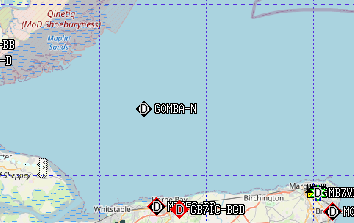
The co-ordinates for APRS must be entered into the Pi-Star in decimal format. You can use Google Earth to find your location in decimal format. Zoom in and click on the map. A pop-up will appear with a decimal version of your Longitude and Latitude.
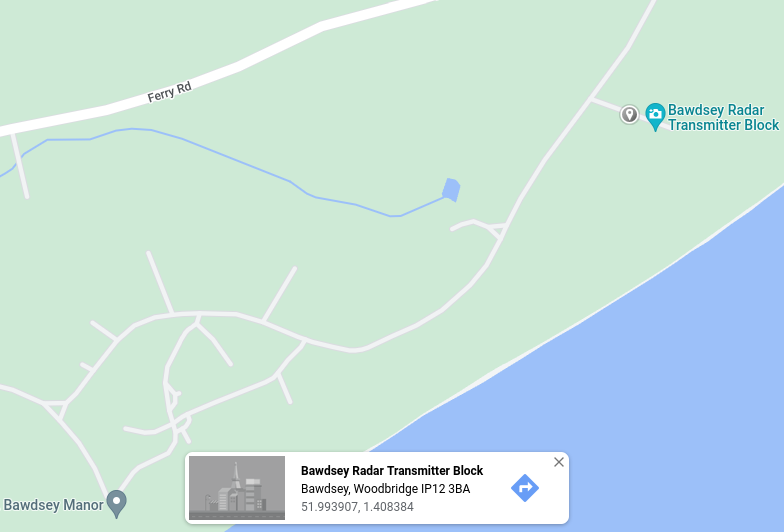
You can also copy the text from the URL in your browser's address bar.

(Yes, they do not match as I created the screen shots at seperate times!)
Programming FT-991(A) Memories
The United Kingdom uses a range of repeater shifts for the 70 cm UHF repeaters. The helpful Automatic Repeater Shift function in the FT-991(A) causes a problem when storing UHF repeaters with shifts more than 1.6 MHz, so it is best to switch both ARS options off.
Press the Menu button and using the multi knob, scroll to menu 084 and 085. Set both of them to OFF.
I use the ADMS programming software from  RT Systems to
set the options and memories. The programming software is handy to restore the radio settings if a firmware update
requires a factory-reset. You can also use it to re-arrange the four option buttons at the bottom of the screen.
In memory mode, I have the SQL and MCH buttons to hand for easy adjustment and easy memory changes.
RT Systems to
set the options and memories. The programming software is handy to restore the radio settings if a firmware update
requires a factory-reset. You can also use it to re-arrange the four option buttons at the bottom of the screen.
In memory mode, I have the SQL and MCH buttons to hand for easy adjustment and easy memory changes.
I have found it is better to disable the option in the ADMS software that automatically sets the offset splits (yellow circle):
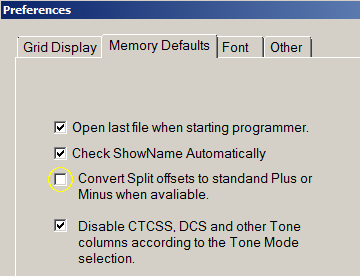
... then set the split frequencies manually for the nearby repeaters, as in the example below:
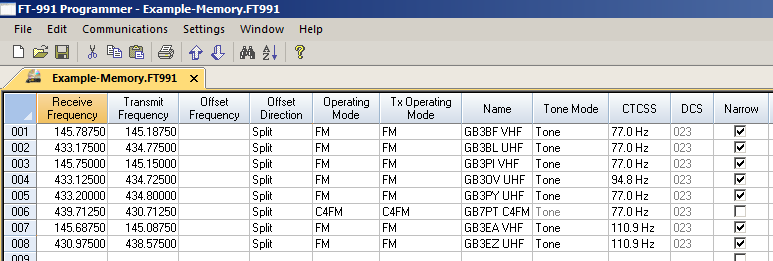
If you would like to re-use my memory layout (I have the VHF simplex channels matching their respective memory number), you are welcome to download examples from the downloads page to use with ADMS.
LDG AT-200 Pro II :: FT-991(A) Interface cable
I had an LDG AT-200 Pro II aerial matcher (they are not tuners!) to match my doublet dipole (changed mid-2018 for a FC-40 and long-wire; and again in 2020 for a Diamon WD-330 Terminated Folder Dipole and no matcher!) to the FT-991(A), and to switch to my Solarcon Imax2000 vertical (retired August 2017). LDG provide an interface cable to drive the FT-991(A). It is available in the UK for around £ 20. You can make one for a lot less!
The details of the interface lead used to be available on the LDG website. They appear to have moved everything to group.io.
The best guide I can offer is this from KN5G  FT-991 with LDG AT 1000 Pro II.
FT-991 with LDG AT 1000 Pro II.
You will need a 3.5mm Stereo Jack Plug to Free Bare Ends Lead and a 3.5mm Stereo jack plug.
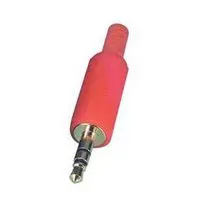 |
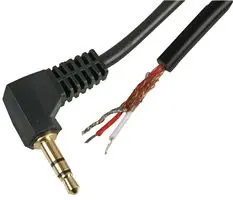 |
The jack to wires is available in the UK from CPC. Saldy, they no longer appear to stock the red plastic jack plug.
 http://cpc.farnell.com/pro-signal/psg03699/3-5mm-3p-jack-to-bare-ends-1m/dp/AV21895
http://cpc.farnell.com/pro-signal/psg03699/3-5mm-3p-jack-to-bare-ends-1m/dp/AV21895
I also suggest searching the likes of ebay for "3.5mm Stereo Jack Plug to Free Bare Ends Lead" and a "3.5mm Stereo solder red" to source the two parts you need.
The cable plugs between the LDG AT-200 Pro II's rear 3.5 mm port (black end) and the FT-991(A)'s REM/ALC port (red end). Using the lead means you cannot use the remote control keypad.
Remember: set Menu 143 TUNER SELECT to LAMP
When you wish to match your aerial to a specific frequency, press and hold the TUNE button on the LDG until the red LEDs (of the top bargraph) come together in the centre. The matching cycle will begin by the LDG commanding CW at 5 Watts from the FT-991(A). That will be increased by 10 dB for the mid part of the matching, then another 3 dB for the final match. The next time you use that frequency, the LDG should remember and automatically engage the necessary L and C relays.
FT-991(A) :: FAST
If you are manually scrolling through VHF with a 12.5 kHz step, or UHF with a 25 kHz step, the multi knob will jump 10x if you have the FAST button set.
How not to make a RF connector!
I detest the PL-259 plug and the SO-239 socket. I would be quite happy if they were banned, consigned to history, and replaced with the vastly superior N-type connector. As I am forced to use the SO-239/PL-259*, I make a point of using high-quality connectors that crimp onto the braid. Cheap connectors are usually poor connectors. Avoid anything that has to be screwed on to the coax!
* Unless the equipment is out of warranty, then there is a chance the SO-239 will be replaced with an N-type socket.
July 2019 - I have repaired a Yaesu FT-767GX and an FL-7000 for local Radio Amateur (a G4 call-sign). Both units required the replacement of their memory batteries - easy enough. The FT-767GX had a keyer fault (blown input gate on Q60); and the FL-7000 had blown PSU transistors and a blown PA transistor. Having repaired the transceiver and amplifier, I was horrified to see this was the connection to one of the aerials:

Click on the image to load a larger version (in a new window).
The inner pin rotates and the coax rotates with it! There is no electrical connection to the braid, despite the solder. This was expected to handle 400 Watts! Needless to say I cut it off and replaced it with a crimp PL-259.
Recommended connectors
I have used and recommend crimp connectors from
Search for "PL 259 crimp" or "N-type crimp" for crimp connectors suitable for RG213.
Page updated: 15th February 2023
Home
|
Tips
|
Awards
|
Linux
|
fldigi
|
APRS
|
QSSTV
|
WSJT-X
|
Projects
|
PSU
|
Repairs
|
Downloads
|
Links
SSTV Gallery
|
eQSL Gallery
|
MQ0PLT eQSL Gallery
|
MQ0PLT eQSL Awards


